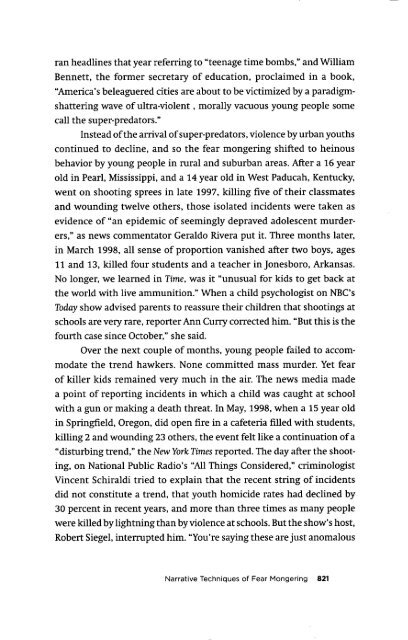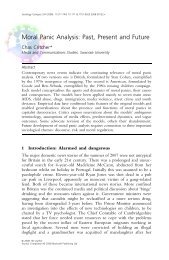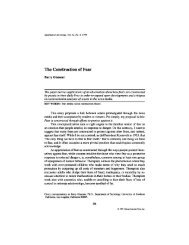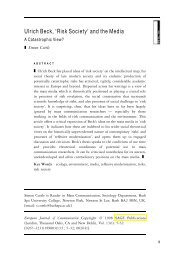Barry Glassner Narrative Techniques of Fear Mongering - Penelope ...
Barry Glassner Narrative Techniques of Fear Mongering - Penelope ...
Barry Glassner Narrative Techniques of Fear Mongering - Penelope ...
Create successful ePaper yourself
Turn your PDF publications into a flip-book with our unique Google optimized e-Paper software.
an headlines that year referring to "teenage time bombs," and William<br />
Bennett, the former secretary <strong>of</strong> education, proclaimed in a book,<br />
"America's beleaguered cities are about to be victimized by a paradigmshattering<br />
wave <strong>of</strong> ultra-violent, morally vacuous young people some<br />
call the super-predators."<br />
Instead <strong>of</strong> the arrival <strong>of</strong> super-predators, violence by urban youths<br />
continued to decline, and so the fear mongering shifted to heinous<br />
behavior by young people in rural and suburban areas. After a 16 year<br />
old in Pearl, Mississippi, and a 14 year old in West Paducah, Kentucky,<br />
went on shooting sprees in late 1997, killing five <strong>of</strong> their classmates<br />
and wounding twelve others, those isolated incidents were taken as<br />
evidence <strong>of</strong> "an epidemic <strong>of</strong> seemingly depraved adolescent murderers,"<br />
as news commentator Geraldo Rivera put it. Three months later,<br />
in March 1998, all sense <strong>of</strong> proportion vanished after two boys, ages<br />
11 and 13, killed four students and a teacher in Jonesboro, Arkansas.<br />
No longer, we learned in Time, was it "unusual for kids to get back at<br />
the world with live ammunition." When a child psychologist on NBC's<br />
Today show advised parents to reassure their children that shootings at<br />
schools are very rare, reporter Ann Curry corrected him. "But this is the<br />
fourth case since October," she said.<br />
Over the next couple <strong>of</strong> months, young people failed to accommodate<br />
the trend hawkers. None committed mass murder. Yet fear<br />
<strong>of</strong> killer kids remained very much in the air. The news media made<br />
a point <strong>of</strong> reporting incidents in which a child was caught at school<br />
with a gun or making a death threat. In May, 1998, when a 15 year old<br />
in Springfield, Oregon, did open fire in a cafeteria filled with students,<br />
killing 2 and wounding 23 others, the event felt like a continuation <strong>of</strong> a<br />
"disturbing trend," the New York Times reported. The day after the shooting,<br />
on National Public Radio's "All Things Considered," criminologist<br />
Vincent Schiraldi tried to explain that the recent string <strong>of</strong> incidents<br />
did not constitute a trend, that youth homicide rates had declined by<br />
30 percent in recent years, and more than three times as many people<br />
were killed by lightning than by violence at schools. But the show's host,<br />
Robert Siegel, interrupted him. "You're saying these are just anomalous<br />
<strong>Narrative</strong> <strong>Techniques</strong> <strong>of</strong> <strong>Fear</strong> <strong>Mongering</strong> 821





